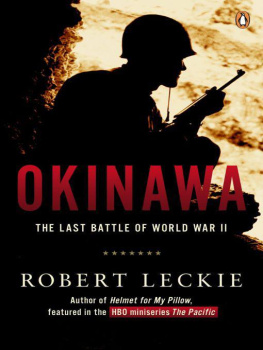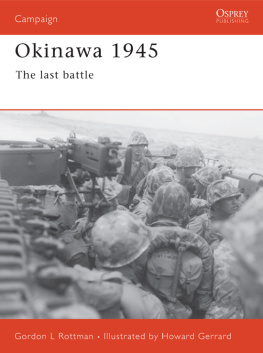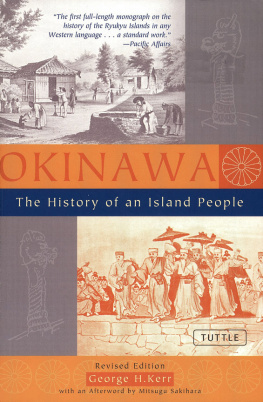BATTLE DIGEST
Lessons for Todays Leaders Volume 2 * Issue 8
World War II:
Okinawa
DATE:
April 1June 22, 1945
LOCATION:
Okinawa Island (Ryukyu Archipelago)
OPPOSING FORCES
United States: 183,000 troops of 10th Army, commanded by Lt. Gen. Simon Bolivar Buckner Jr. His two corps commanders were Marine Maj. Gen. Roy S. Geiger (III Marine Amphibious Corps) and Maj. Gen. John R. Hodge (Army XXIV Corps). They were supported by the Fifth Fleet, commanded by Adm. Raymond A. Spruance. Fleet Admiral Chester W. Nimitz, Commander-in-Chief Pacific Ocean Areas, was in overall command of the operation.
Imperial Japan: 100,000 army and navy troops of the 32nd Army Group, commanded by Lt. Gen. Mitsuru Ushijima. His subordinate units were two infantry divisions (24th and 62nd), along with the 44th Independent Mixed Brigade (understrength due to the loss of 5,600 men when their transport was torpedoed by an American submarine on its way to Okinawa). An estimated 4,500 kamikaze suicide pilots also participated in the battle.
HISTORICAL SIGNIFICANCE
By early 1945, American forces had been fighting their way across the Pacific for over two and a half years. General Douglas MacArthurs drive in the Southwest Pacific had reached the Philippines, while Admiral Chester Nimitzs drive across the Central Pacific had advanced to the island of Iwo Jima. The next objective was Okinawa. With the capture of this key island, only 340 miles from the Japanese mainland, the Allies would secure their final staging base for the invasion of Japan. In the largest amphibious assault of the Pacific War, soldiers and Marines would grind through 82 days of grueling combat. At the same time, U.S. and Allied ships would suffer their worst losses of the war from waves of Japanese kamikazes. But with this important victory, the Allies path to Japan was finally open.
STRATEGY & MANEUVER
Actions by the United States: After the stunning American victory at Midway, U.S. forces went on the offensive. Beginning in August 1942 with the attack on Guadalcanal, U.S. forces began reversing Japanese gains while cutting their lines of communication and supply in the Southwest Pacific. As the hard drive up the island chains continued, the Joint Chiefs designated two mutually supporting lines of advance. The first, led by MacArthur, would continue from the south, moving up through New Guinea, into the Philippines, and ultimately into Luzon. The second drive, led by Nimitz, would move across the Central Pacific from the east, through the Gilberts, Marshalls, Carolines, and Marianas to Iwo Jima. Eventually, both efforts would converge south of Japan to prepare for the final invasion. () For two and a half years, both MacArthur and Nimitz pushed on against a determined enemy. Eventually, with MacArthurs forces firmly in the Philippines and Nimitzs victory on Iwo Jima, the stage was set for Operation Iceberg, the seizure of Okinawa.

The 1 April, 1945, assault would be the largest invasion of the Pacific War, with 1,300 warships and transports carrying nearly 183,000 troops. Lt. Gen. Simon Bolivar Buckner Jr.s 10th Army would lead the operation, while Adm. Raymond A. Spruances Fifth Fleet would provide direct support offshore. Buckners plan was straightforward. Prior to the invasion, the Armys 77th Division would seize the nearby Kerama Islands for naval seaplane and fleet bases, followed by securing Keisa Shima Island for XXIV Corp 155 mm artillery to provide support for the landings. On invasion day, he would fix the Japanese with a demonstration at the Minatoga beaches in the southeast, while executing his main effort with two corps landing abreast on the western Hagushi beaches. Once ashore, they would drive east, capture two vital airfields (Yontan and Kadena), then split the island in two. Maj. Gen. John Hodges XXIV Corps would then clear southern Okinawa while Maj. Gen. Roy Geigers III Amphibious Corps held the center of the island. Once reunited, both corps would drive into what was expected to be the more heavily defended north.
On 22 March, U.S. minesweepers cleared the approaches to the Kerama Islands and Okinawa. The following day, the 77th Division landed in the Keramas and found over 300 suicide boats packed with explosives. On the 31st, XXIV Corps artillery landed and emplaced their guns. All the while, carrier-based aircraft and naval guns provided fire support.
Actions by Japan: In the months preceding Okinawa, Japans strategy was primarily defensive. As her forces worked desperately to blunt U.S. advances toward the home islands, the Japanese hoped to exact a heavy toll on the Americans and negotiate a favorable peace. By the time the Allies captured Iwo Jima in March 1945, Japanese intelligence had a clear picture of follow-on Allied objectives. Still, the Japanese remained confident that attrition might deter a final American invasion of their homeland.
The defense of Okinawa fell to Lt. Gen. Mitsuru Ushijima, commander of the 32nd Army. Arriving on the island in August 1944, he was under no illusions as to the eventual outcome of the looming battle. His goal was to buy time for Japan to strengthen home defenses while exacting the highest possible toll on the Americans.
Against the guidance of the Imperial General Staff, Ushijima wouldnt contest the landings. Instead, he would dig in, endure the pre-invasion pounding, then draw his attackers into his elaborate defensive positions. Using minimal forces in the north, he placed the bulk of his army in the south, along three defensive lines. With the support of kamikazes and remnants of the once mighty Imperial Japanese Navy, he hoped to cut off and isolate his attackers.
Ushijima fortified the hills, ridges, caves, draws, and ravines in southern Okinawa with pillboxes, bunkers, and machine-gun nests all with interlocking fields of fire. He preregistered artillery and mortars on avenues of approach, while building honeycombs of subterranean tunnels and passages along the high ground. By the time the American pre-invasion bombardment began, Ushijima was resigned and ready.

Map 1: Overview of the Pacific strategy.
TACTICS OF THE BATTLE
The Battle of Okinawa was a large amphibious assault followed by an 82-day ground battle. At the same time, it was a battle at sea between Allied ships and relentless kamikaze attacks.
The initial push On 1 April, the predawn calm over Okinawa was shattered by the greatest barrage of naval gunfire in history. Over 100,000 shells, rockets, and mortars rained down on the island as waves of landing craft moved toward the shore. () Twenty miles south, Rear Adm. Jerauld Wrights Demonstration Group, carrying the 2nd Mar. Div., moved toward Okinawas Minatoga beaches to fool the Japanese regarding 10th Armys main effort. Several kamikazes roared overhead, striking three U.S. craft, before Wrights group moved off to the east.
When 10th Armys first waves hit the beaches, they rapidly moved ashore 16,000 men in the first hour. Something seemed off, however. The expected heavy resistance wasnt there. The answer lay with Ushijima, who watched patiently from his bunker at Shuri Castle.
By the end of the day, Buckner had 60,000 men ashore from the 6th Mar. Div., 1st Mar. Div., 7th Inf. Div., and 96th Inf. Div., with minimal casualties. Both Kadena and Yontan airfields were in American hands. By day three, the 7th Inf. Div. and 1st Mar. Div. had raced across the island cutting Okinawa in half. By the end of day four, U.S. troops had occupied ground expected to take three weeks of tough combat. With the airfields operational, Marine and Army aircraft flew in from carriers to support the fight.











